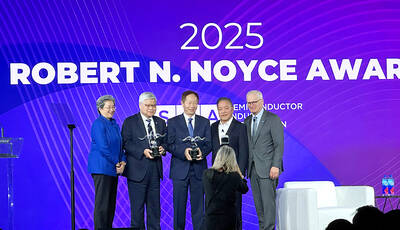Business sentiment of Asian companies sank to an 11-year low in the second quarter, a Thomson Reuters/INSEAD survey found, with about two-thirds of the firms surveyed flagging a worsening COVID-19 pandemic as the biggest risk over the next six months.
While the pandemic’s initial impact was reflected in the March survey, confidence during this quarter fell by a third to 35, only the second time that the Thomson Reuters/INSEAD Asian Business Sentiment Index has slumped below 50 since the survey began in the second quarter of 2009.
A reading above 50 indicates a positive outlook.

Photo: AFP
The last time the index showed a reading below that was in its debut quarter, when it hit 45.
About 16 percent of the 93 companies surveyed also said that a deepening recession was a key risk for the next six months, with more than half expecting staffing levels and business volumes to decline.
“We ran this survey right at the edge when things were getting really bad,” Antonio Fatas, a Singapore-based economics professor at the global business school INSEAD, said of the survey conducted between May 29 and Friday last week.
“We can see this complete pessimism which is spread across sectors and countries in a way that we haven’t seen before,” he said.
Many nations are easing COVID-19-related lockdowns, but worries have mounted that another wave of infections could hurt economies that have been battered from weeks of curbs on travel and movement.
Coronavirus cases globally have crossed 8 million.
After weeks with almost no new COVID-19 infections, China recorded dozens of new cases this week, roiling fragile equity markets. South Korea also faces an uptick after early successful containment.
Companies from 11 Asia-Pacific nations responded to the Thomson Reuters/INSEAD survey.
Participants included Taiwanese contract manufacturer Wistron Corp (緯創), Thai hospitality group Minor International PCL (MINT), Japanese automaker Suzuki Motor Corp and Australia-listed Oil Search Ltd.
China, where COVID-19 was first detected, reported that industrial output quickened for a second straight month last month, but a weaker-than-expected gain suggested that the recovery remains fragile.
“It tells us that the recovery will take time and it won’t be a V-shaped recovery,” said Jeff Ng, senior treasury strategist at HL Bank Singapore (豐隆銀行).
Governments have rolled out stimulus measures to support ailing economies. Singapore and Hong Kong, among the most open economies in Asia, have backed sectors such as airlines that are bearing the brunt of travel restrictions.
The US Federal Reserve last week said that it would likely hold its benchmark interest rate near zero through 2022, signaling it expects a long road to recovery.
However, recessions in most major economies are still expected to be more severe this year than forecast, Reuters polls of more than 250 economists published late last month showed.
Chaiyapat Paitoon, chief strategy officer at Bangkok-based MINT — which operates brands such as Marriott and Four Seasons, and gets the bulk of its revenue from Europe — said that the company had taken several cost-saving measures to minimize the impact on its profits.
“MINT’s main priorities are to survive, stabilize and grow,” Paitoon said.

Shiina Ito has had fewer Chinese customers at her Tokyo jewelry shop since Beijing issued a travel warning in the wake of a diplomatic spat, but she said she was not concerned. A souring of Tokyo-Beijing relations this month, following remarks by Japanese Prime Minister Sanae Takaichi about Taiwan, has fueled concerns about the impact on the ritzy boutiques, noodle joints and hotels where holidaymakers spend their cash. However, businesses in Tokyo largely shrugged off any anxiety. “Since there are fewer Chinese customers, it’s become a bit easier for Japanese shoppers to visit, so our sales haven’t really dropped,” Ito

The number of Taiwanese working in the US rose to a record high of 137,000 last year, driven largely by Taiwan Semiconductor Manufacturing Co’s (TSMC, 台積電) rapid overseas expansion, according to government data released yesterday. A total of 666,000 Taiwanese nationals were employed abroad last year, an increase of 45,000 from 2023 and the highest level since the COVID-19 pandemic, data from the Directorate-General of Budget, Accounting and Statistics (DGBAS) showed. Overseas employment had steadily increased between 2009 and 2019, peaking at 739,000, before plunging to 319,000 in 2021 amid US-China trade tensions, global supply chain shifts, reshoring by Taiwanese companies and

Taiwan Semiconductor Manufacturing Co (TSMC, 台積電) received about NT$147 billion (US$4.71 billion) in subsidies from the US, Japanese, German and Chinese governments over the past two years for its global expansion. Financial data compiled by the world’s largest contract chipmaker showed the company secured NT$4.77 billion in subsidies from the governments in the third quarter, bringing the total for the first three quarters of the year to about NT$71.9 billion. Along with the NT$75.16 billion in financial aid TSMC received last year, the chipmaker obtained NT$147 billion in subsidies in almost two years, the data showed. The subsidies received by its subsidiaries —

Taiwan Semiconductor Manufacturing Co (TSMC) Chairman C.C. Wei (魏哲家) and the company’s former chairman, Mark Liu (劉德音), both received the Robert N. Noyce Award -- the semiconductor industry’s highest honor -- in San Jose, California, on Thursday (local time). Speaking at the award event, Liu, who retired last year, expressed gratitude to his wife, his dissertation advisor at the University of California, Berkeley, his supervisors at AT&T Bell Laboratories -- where he worked on optical fiber communication systems before joining TSMC, TSMC partners, and industry colleagues. Liu said that working alongside TSMC